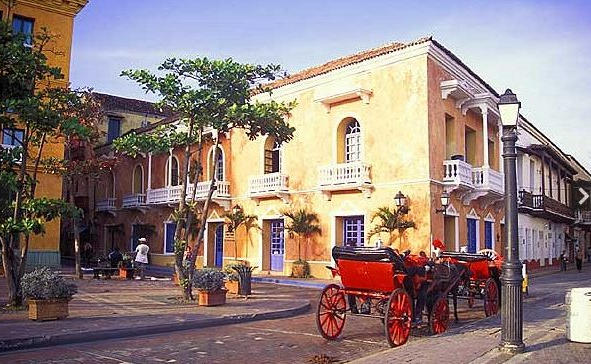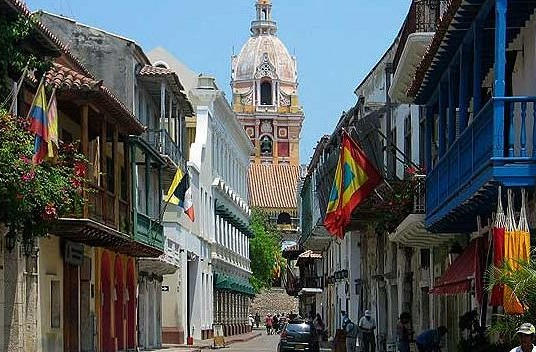Cartagena must be the most beautiful colonial-style settlement in the Caribbean. No wonder the literary elite will be back in January for the Hay Festival.
Via telegraph.co.uk/travel/TodayColombia
Birdwatching has never been high on my list of hobbies. Yet there I was, standing in the cathedral square of Cartagena de Indias, squinting into the late-afternoon sunshine for a flash of green feathers.
A conversation from the previous night had led me there. “Did you know there are a couple of parrots that hang out at the cathedral? If you’re there at around five in the evening, go look up at the roof. They’re really nice birds.” So enthused the bespectacled, middle-aged man, in his sensible shoes and perfectly pressed jeans, as he proclaimed Colombia the birding capital of the world.
Under normal circumstances, the subject matter would have had me nodding politely and edging towards the exit. But the twitcher in question was Jonathan Franzen, the superstar American author, so I was rapt.
Franzen was speaking to an audience at the Hay Festival Cartagena, held each January in this walled city on the Caribbean coast. If there is a more magical setting for a literary festival, I’d like to find it. For four days, some of the world’s leading writers and thinkers gather there to exchange ideas. Banish all thoughts of po-faced intellectual debate.
Cartagena is not that kind of place. It’s the kind of place where the author of The Corrections and Freedom dispenses parrot-watching tips (sadly, I never did see them), where the president drops in to talk about drug legalisation, before popping up at a house party, and where you are as likely to bump into famous people enjoying a mojito in a late-night salsa joint as you are to catch them on stage. Throw in a tropical climate, and this has to be the best date in the literary calendar.
In the courtyard of the Santa Clara, a former monastery and now the city’s swishiest hotel, I spotted Andrew Davies, king of the bodice-ripping period adaptation and there to discuss Dickens. Was he enjoying the festival? “Are you kidding?” he laughed, gesturing around him. “Cartagena is fabulous.”
The British have been of that view for rather a long time. In the 16th century, it was the port through which gold, silver and precious stones were stored en route from Peru, before being loaded onto galleons bound for Spain. Such treasures proved irresistible to Sir Francis Drake, who sacked the city in 1586. As Mauricio Rodríguez, the Colombian ambassador to Britain, puts it: “Cartagena was very attractive to pirates. In the UK you call them ‘privateers’. Call them whatever you want, but for us it’s pirates, pirates, pirates! And we want our gold and silver back…”
He delivers this with a smile on his face and a twinkle in his eye. He is as delighted as anyone that Cartagena is an increasingly popular tourist destination for the British. Thirty years ago, it was all very different. While money was being invested in the areas outside the city walls, transforming the seafront Bocagrande district into a Miami-style resort crammed with high-rise hotels, the colonial heart of Cartagena was in a sorry state.
The process of gentrification began, as it does the world over, with a handful of far-sighted incomers buying and restoring dilapidated properties. Cafés, bars and restaurants followed. Now these former merchants’ houses – typically constructed on three or four levels around shady courtyards and hidden behind huge wooden doors – fetch $10 million (£6.23 million), and there are more upmarket restaurants per square foot than in the borough of Kensington and Chelsea.
“Colombians now see that Cartagena is unique. It sometimes takes outsiders’ eyes to make you see you have something special,” says Mr Rodriguez. “People realised that the real value of a city is in its history.”
This is surely the most beautiful colonial city in the Caribbean, its grandeur recognised by its designation as a Unesco World Heritage Site. Every street is a picture-postcard image, with buildings painted in vivid yellows, pinks and cerulean blues. The romance of the place is inescapable – just ask Colin Firth, who first set eyes on his wife, Livia, there in 1995. “We met in Cartagena – a staggeringly beautiful city full of staggeringly beautiful people,” he recalled. “I was on the steps of a very old church and I saw her coming through the crowd. And that was it: a bolt to the heart.”
That sense of romance is heightened by the spirit of Gabriel García Márquez. The great Colombian novelist spent a formative part of his career in Cartagena – his modernist house occupies a high spot overlooking the sea, and he visits when health allows – and fell under its spell. “All of my books have loose threads of Cartagena in them,” he once said. The tourist board offers an excellent audio tour guiding visitors to locations that inspired his novels – chiefly Love in the Time of Cholera – and short stories. But if the idea of following directions with headphones clamped to your ears feels a little too touristy, don’t worry. Take a stroll around Cartagena at your own pace and you can’t help but soak up the dreamy atmosphere that pervades Márquez’s fiction.
Other cities in Colombia – unfairly or not – may retain a reputation as tourist no-go areas, but I felt no danger walking Cartagena’s streets, even at night. Some have taken this, coupled with the prettiness of the place, to mean the old town is a “Disneyfied” version of Colombia. But this is as real a representation of the country as the grittier Bogotá, and tourists are far outnumbered by locals going about their business.
The latest area to gentrify is Getsemaní, a five-minute cab ride outside the walls and currently the place for nightlife in a city renowned for its party atmosphere. It is home to Café Havana, which feels as if it has been there for centuries but actually opened in 2006 and is the sort of bar you fantasise about stumbling across on your travels: wonderful live music and an irresistible buzz that will have even the most reluctant wallflowers breaking into an involuntary salsa. Just Google “Hillary Clinton Colombia” for pictorial evidence.
A night at Café Havana lives long in the memory, but drinking in Cartagena is not all about destination bars. Much fun can be had visiting a hole-in-the-wall joint for a shot of rum, best drunk from a paper cup while sitting on the pavement and watching the world go by. For a non-alcoholic pit-stop during the day, seek out Lonchería Bolívar on the corner of Calle de Nuestra Señora del Andrina. This tiny snack bar sells freshly pulped exotic juices with unfamiliar names: take potluck with curuba, chontaduro, tamarillo or guanabana.
Eating out is another tale of two halves. Just about every restaurant serves ceviche: raw fish marinated in lime juice with a kick of chilli. It’s that rare combination of tasty and healthy – unlike arepas, another local speciality of fried corn patties stuffed with cheese or meat and served with a spicy sauce. Artery-clogging, but equally delicious. They’re usually served for breakfast, so it’s advisable to spend the next few hours walking them off.
Fortunately, walking is the best way to get around Cartagena. The place is so compact and easy to navigate that I had dispensed with the map by day two. There is something different to discover in every plaza: old-timers play chess in the leafy shade of Plaza de Bolívar; the sun-drenched Plaza de Santa Domingo is home to pavement cafés and the “fat lady” statue by Fernando Botero, the celebrated Colombian sculptor. A visit to the Palace of the Inquisition is a must: a sample list of questions demanded of “witches” under interrogation includes: “What demons attended your wedding?” It all seems a bit Monty Python, until you wander into the next room and the display of torture equipment brings you up short.
The best way to get a feel for the city’s history is to walk its walls. The Spanish arrived in 1533, but repeated raids by Drake and his ilk prompted an epic fortification project that was finally completed in the early 18th century, with the Castillo San Felipe de Barajas towering above the sea and walls up to 30ft thick encircling the city. In 1741, a British fleet led by Admiral Edward Vernon launched the Battle of Cartagena. The walls proved impregnable: the Spanish claimed a famous victory against the might of 186 British ships and 12,000 infantry.
Culture, not plundered treasure, is now the main currency in Cartagena, with festivals of film, music and dance on the calendar. The lovely Adolfo Mejia Theatre, built as an opera house in 1911, is the main venue and this January it will host Hay Festival speakers, including Julian Barnes and Mario Vargas Llosa, winners of the Man Booker Prize and the Nobel Prize for Literature respectively. They are in distinguished company. Last year it was an appearance by Carlos Fuentes, Mexico’s grand old man of letters, that proved to be the highlight.
Authors are revered in Latin America as nowhere else on Earth, and Fuentes, aged 83, arrived on stage to a hero’s welcome from an audience that ranged from schoolchildren to the country’s political elite. We did not know that it would be one of his last public appearances – he died four months later – but what a privilege it was to see him discussing his passion for literature in this setting (his reply when asked to name the five most important books to read: “Don Quixote, Don Quixote, Don Quixote, Don Quixote, Don Quixote.”).
Fuentes spoke of the future and a new generation of Latin American authors who no longer need to explore the region’s past because “the story of what happened before has already been told”. It has, but in Cartagena that story surrounds you – and it is worth retelling.



